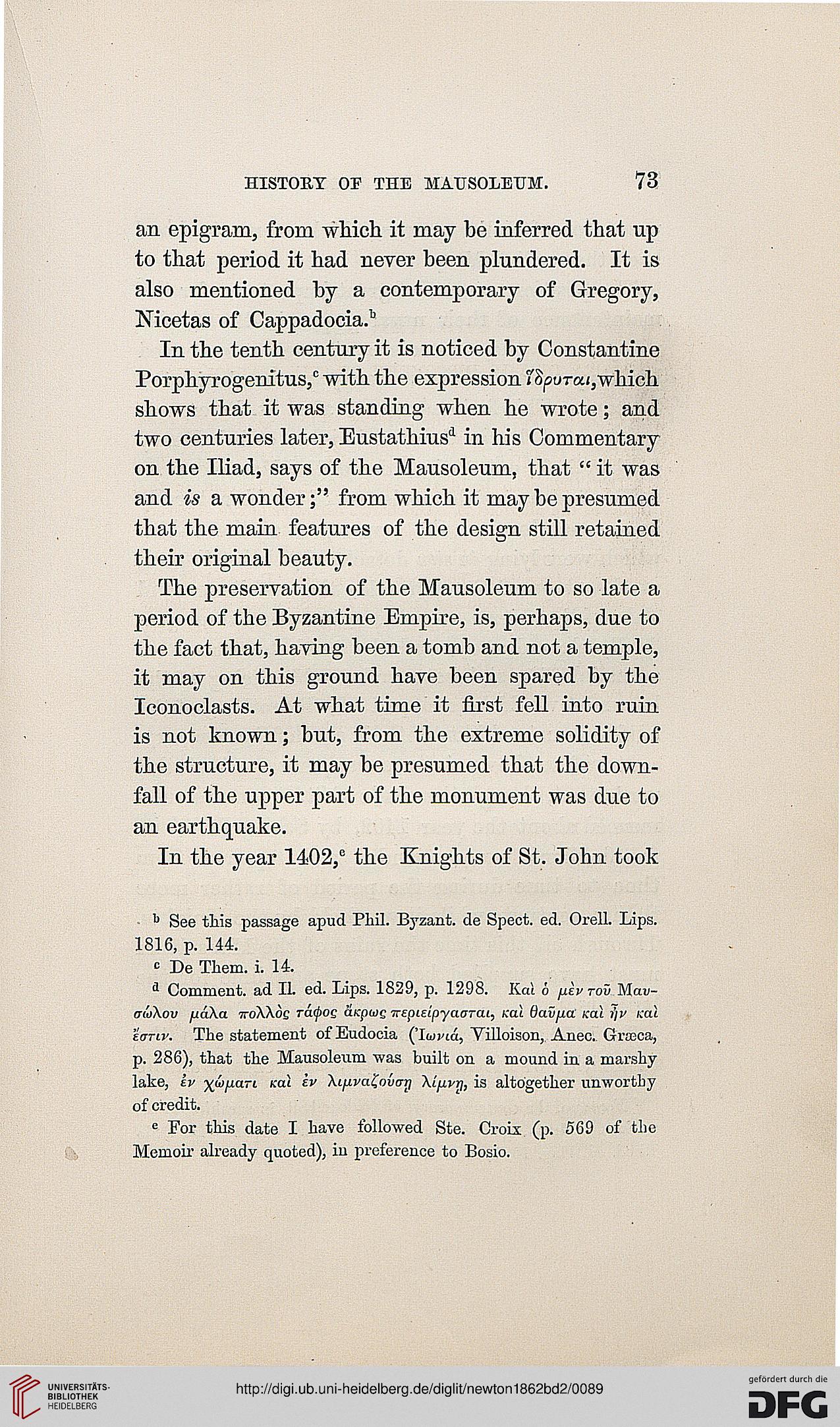HISTOBT OE THE MAUSOLEUM. 73
an epigram, from which it may be inferred that up
to that period it had never been plundered. It is
also mentioned by a contemporary of Gregory,
Mcetas of Cappadocia.b
In the tenth century it is noticed by Constantine
Porphyrogenitus,0 with the expression j'Spurai,which
shows that it was standing when he wrote; and
two centuries later, Eustathiusd in his Commentary
on the Iliad, says of the Mausoleum, that " it was
and is a wonder;" from which it may be presumed
that the main features of the design still retained
their original beauty.
The preservation of the Mausoleum to so late a
period of tbe Byzantine Empire, is, perhaps, due to
the fact that, having been a tomb and not a temple,
it may on this ground have been spared by the
Iconoclasts. At what time it first fell into ruin
is not known; but, from the extreme solidity of
the structure, it may be presumed that the down-
fall of the upper part of the monument was due to
an earthquake.
In the year 1402,c the Knights of St. John took
b See this passage apud Phil. Byzant. de Speet. ed. Orell. Lips.
1816, p. 144.
c De Them. i. 14.
d Comment, ad II. ed. Lips. 1829, p. 1298. Km 6 iievtov Mav-
aw\ov uaXa woWog rcKpog axpuc; irEpisipyaarat, Kal dav/ia teal i]v ml
ianv. The statement of Eudocia (Tw^ta, Yilloison, Anec. Gra2ca,
p. 286), that the Mausoleum was built on a mound in a marshy-
lake, iv yufiari kcu iv \i\iva^nva^ Xijxvrj, is altogether unworthy
of credit.
e For this date I have followed Ste. Croix (p. 569 of the
Memoir already quoted), in preference to Bosio.
an epigram, from which it may be inferred that up
to that period it had never been plundered. It is
also mentioned by a contemporary of Gregory,
Mcetas of Cappadocia.b
In the tenth century it is noticed by Constantine
Porphyrogenitus,0 with the expression j'Spurai,which
shows that it was standing when he wrote; and
two centuries later, Eustathiusd in his Commentary
on the Iliad, says of the Mausoleum, that " it was
and is a wonder;" from which it may be presumed
that the main features of the design still retained
their original beauty.
The preservation of the Mausoleum to so late a
period of tbe Byzantine Empire, is, perhaps, due to
the fact that, having been a tomb and not a temple,
it may on this ground have been spared by the
Iconoclasts. At what time it first fell into ruin
is not known; but, from the extreme solidity of
the structure, it may be presumed that the down-
fall of the upper part of the monument was due to
an earthquake.
In the year 1402,c the Knights of St. John took
b See this passage apud Phil. Byzant. de Speet. ed. Orell. Lips.
1816, p. 144.
c De Them. i. 14.
d Comment, ad II. ed. Lips. 1829, p. 1298. Km 6 iievtov Mav-
aw\ov uaXa woWog rcKpog axpuc; irEpisipyaarat, Kal dav/ia teal i]v ml
ianv. The statement of Eudocia (Tw^ta, Yilloison, Anec. Gra2ca,
p. 286), that the Mausoleum was built on a mound in a marshy-
lake, iv yufiari kcu iv \i\iva^nva^ Xijxvrj, is altogether unworthy
of credit.
e For this date I have followed Ste. Croix (p. 569 of the
Memoir already quoted), in preference to Bosio.




